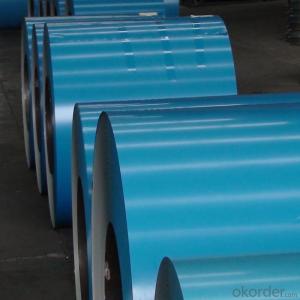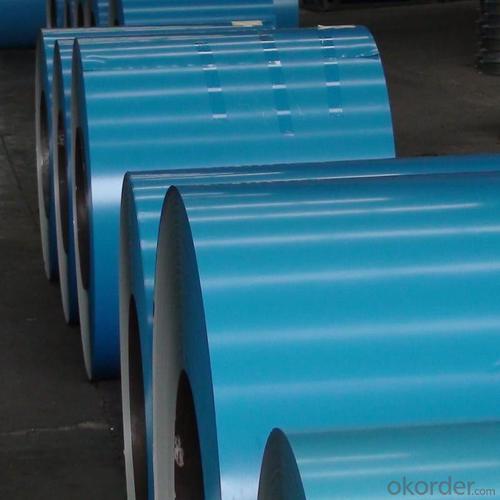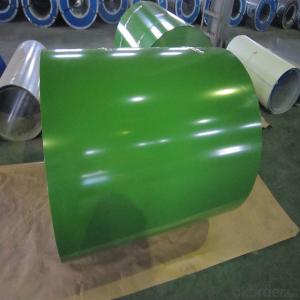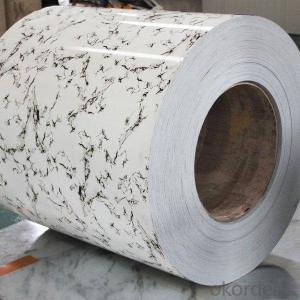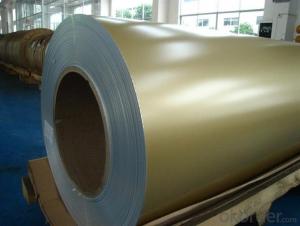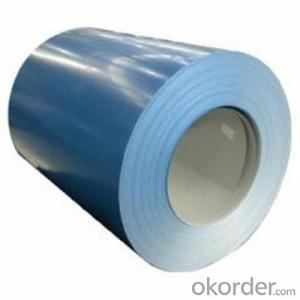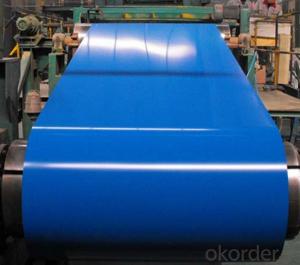Prepainted Galvalume Rolled Coil for Construction roof
- Loading Port:
- Shanghai
- Payment Terms:
- TT OR LC
- Min Order Qty:
- 25 m.t.
- Supply Capability:
- 30000 m.t./month
OKorder Service Pledge
OKorder Financial Service
You Might Also Like
Structure of Prepainted Galvalume Rolled Coil

Description of Prepainted Galvalume Rolled Coil
Aluminum zinc coils is a kind of coated steel coil/sheet. With the cold rolled steel of different strength and thickness as substrate, it is produced through applying Al-Zn coat on both faces by hot dip process. In its coating, Al accounts for about 55%, Si 1.6%, while the remaining is Zn. Aluminum zinc coils enjoys both the physical protective feature and durability of Al and the electrochemical protective property of Zn. And its surface has bright silver color and regular embossed-like figure, which are highly decorative.
Main Feature of Prepainted Galvalume Rolled Coil
1.Corrosion resistance: It mainly depends on the aluminum protection. When the zinc being worn, the aluminum will form a dense layer of aluminum oxide, resist corrosion material to prevent further corrosion inside.
2. Heat resistance: Aluminum zinc alloy steel sheet has excellent heat resistance, can withstand high temperatures over 300 centigrade, and is similar with aluminized steel high temperature oxidation resistance. It often used in chimney pipes, ovens, fluorescent lighting device and the device cover.
3. Heat reflective: Galvanized steel plate heat-reflective high rate is twice as galvanized steel, often used to make insulation materials.
4. Economy: Because density of 55% AL-Zn is smaller than the density of Zn, so in the same weight and thickness of Galvanized zinc layer, aluminum-zinc steel plate is larger area more than 3% of galvanized steel sheet.
Applications of Prepainted Galvalume Rolled Coil
1. Construction and building: roofing; ventilating duct; handrail; partition panel;etc.
2. Electric appliance: refrigerator; washing machine; refrigerator; DVD;etc.
3.Transportation: oil tank; road sign; etc.
4.Agriculture:barn; etc.
5.Others:vending machine; game machine; etc.
Prepainted Prepainted Galvalume Rolled Coil
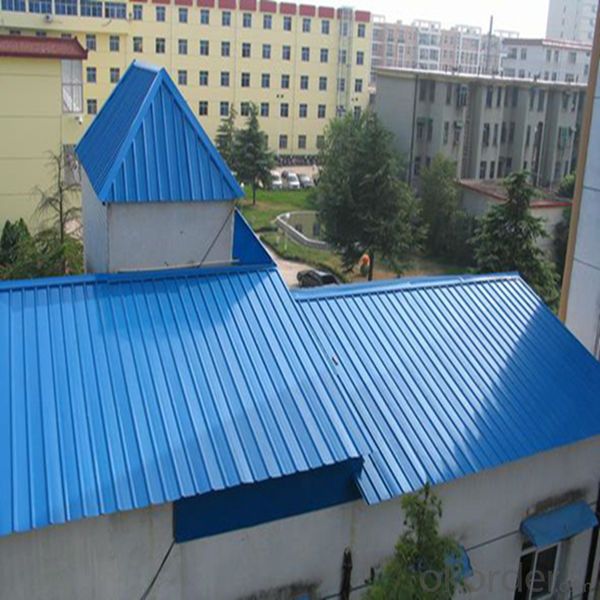
Specifications of Prepainted Galvalume Rolled Coil
Structure | |||
Item | Thickness | Type | Feature |
Laminated film | 50μm | Polyethylene | Protecting from scratchs and contamination(option) |
Top coat | 20μm | Polyester Fluorine | Chemical resistance and formability |
Primer coat | 5μm | Polyester | Workability, corrosion resistance and adhesion to the primer coating |
Chemical treatment | 1μm | Chromate | Good adhesion and corrosion resistance |
Substrate | 0.2mm-1.2mm | GI.GL,AL | GI.GL,AL |
Back coat | 5±2μm | Epoxy | Corrosion resistance and adhesion to the substrate |
FAQ of Prepainted Aluminum Zinc Rolled Coil for Construction
We have organized several common questions for our clients,may help you sincerely:
1. What is the minimum order quantity ?
Our MOQ is 50mt for each size. And we will consider to give more discount if you make big order like 1000 tons and more. Further more, the more appropriate payment term your offer the better price we can provide.
2. How long can we receive the product after purchase?
Usually within thirty working days after receiving buyer’s advance payment or LC. We will arrange the factory manufacturing as soon as possible. The cargo readiness usually takes 15-25 days, but the shipment will depend on the vessel situation.
3. How to guarantee the quality of the products?
We have established the international advanced quality management system,every link from raw material to final product we have strict quality test;We resolutely put an end to unqualified products flowing into the market. At the same time, we will provide necessary follow-up service assurance.
- Q: What are the common coil grades available for steel coils?
- The common coil grades available for steel coils are typically classified into three main categories: low carbon steel, medium carbon steel, and high carbon steel.
- Q: How are steel coils used in the production of steel tanks?
- Steel tanks rely on steel coils as a vital element in their production. These coils, typically made from top-notch steel, act as the primary raw material for manufacturing steel tanks. The initial step involves unrolling and flattening the steel coils, which are usually supplied in a coiled form from the steel mills. Once unrolled, the coils are then cut into specific lengths and widths, depending on the desired dimensions of the steel tank. These cut pieces are molded and shaped into various tank components, including the cylindrical body, top and bottom ends, and additional fittings or accessories. The strength and durability of the tank heavily depend on the steel coils, ensuring its ability to withstand the demands of its intended use. The quality of the steel used in the coils is pivotal as it determines the tank's resistance to corrosion, pressure, and external forces. Additionally, employing steel coils enables efficient and cost-effective manufacturing of steel tanks. The standardized nature of the coils ensures consistent quality and dimensions, streamlining the production process. Precise cutting of the coils also minimizes waste and maximizes material utilization. Furthermore, steel coils offer design flexibility and customization options. They are easily formed and welded into intricate shapes, accommodating tanks of varying sizes, capacities, and configurations. This versatility makes steel coils the ideal choice for producing tanks across diverse sectors, including industrial, commercial, and residential applications. In conclusion, steel coils play a critical role in steel tank production. They provide the necessary raw material for manufacturing different tank components, guaranteeing strength, durability, and customization. By utilizing steel coils, manufacturers can efficiently produce high-quality tanks that meet the specific requirements of various industries.
- Q: How are steel coils processed for slitting or shearing?
- Steel coils are processed for slitting or shearing by first unwinding the coil and then passing it through a set of rotating circular blades. The blades cut the steel coil into narrower strips, which are then either rewound into smaller coils (slitting) or cut into individual sheets (shearing). This process allows for the production of various sizes and shapes of steel products for different applications.
- Q: Can i use steel shot in a remington 870 wingmaster full choke 30 inch barrel. the shotgun is in great shape and about 20 or 25 years old probably. thank you. the steel shot i have got is 12 gauge 2 3/4 in 1550 velocity 1 1/16 oz 2 shot winchester xpert high velocity steel shot
- Remington Steel Shot
- Q: If you keep it dry and clean, what steel will last the longest over the years with continued use and sharpening?
- you eventually will wear the blade out. i have seen old guys pocketknives that they used for whittlin and the blades have deep curves in them like khukris from wear. i reccommend, 440 stainless, or something with a rockwell hardness rating above 45.
- Q: What are the different methods of leveling steel coils?
- There are several different methods of leveling steel coils, including roller leveling, stretcher leveling, and tension leveling. Roller leveling involves passing the coil through a series of rollers to flatten it. Stretcher leveling uses a hydraulic stretcher to stretch the coil in order to remove any residual stresses. Tension leveling involves applying tension to the coil while passing it through a series of rollers, which helps to eliminate any waviness or unevenness.
- Q: What is the role of steel coils in the manufacturing of bridges?
- Steel coils play a crucial role in the manufacturing of bridges as they are used to produce the beams and girders that provide the structural support and strength needed for the bridge. These coils are formed into various shapes and sizes, allowing for the customization required in bridge construction. Additionally, the high strength and durability of steel make it an ideal material for withstanding the heavy loads and harsh environmental conditions bridges are subjected to.
- Q: How are steel coils inspected for chemical composition using spectroscopy?
- Steel coils can be inspected for their chemical composition using spectroscopy, specifically techniques like X-ray fluorescence (XRF) or laser-induced breakdown spectroscopy (LIBS). In XRF, an X-ray beam is directed onto the surface of the steel coil, causing the atoms in the sample to emit characteristic X-ray fluorescence radiation. By analyzing the energy and intensity of these emitted X-rays, the elemental composition of the steel can be determined. XRF is a non-destructive and rapid technique, allowing for quick and accurate assessment of the chemical composition of the steel coil. LIBS, on the other hand, involves focusing a laser beam onto the surface of the steel coil, creating a high-temperature plasma. The plasma emits light, which is then collected and analyzed using a spectrometer. The emitted light contains characteristic atomic and ionic emissions, allowing the identification and quantification of various elements present in the steel. LIBS is also a non-destructive technique, providing real-time results and requiring minimal sample preparation. Both XRF and LIBS offer advantages in terms of speed, non-destructiveness, and ease of use for inspecting steel coils for their chemical composition. These spectroscopic techniques play a crucial role in quality control and assurance, ensuring that the steel meets the required specifications and standards for various industrial applications.
- Q: How are steel coils tested for strength?
- Steel coils are tested for strength using a variety of methods such as tensile testing, hardness testing, and impact testing. Tensile testing involves applying a controlled force to the coil until it breaks, measuring the amount of force required to rupture the steel. Hardness testing measures the resistance of the steel to indentation or scratching, providing an indication of its strength. Impact testing evaluates the ability of the steel to absorb energy under sudden loading conditions. These tests help determine the overall strength and quality of the steel coils.
- Q: What are the cost considerations when purchasing steel coils?
- When purchasing steel coils, there are several cost considerations to take into account. Firstly, the price per ton of the steel coils is a significant factor. This can vary depending on factors such as the grade and quality of the steel, market demand, and supplier pricing. Secondly, transportation costs should be considered, as steel coils are heavy and may require special handling and shipping arrangements. Additionally, potential additional costs such as taxes, customs duties, insurance, and storage fees should be factored in. Lastly, the total cost of ownership, which includes factors like maintenance, repair, and energy consumption, should be considered to ensure a comprehensive understanding of the overall cost implications of purchasing steel coils.
Send your message to us
Prepainted Galvalume Rolled Coil for Construction roof
- Loading Port:
- Shanghai
- Payment Terms:
- TT OR LC
- Min Order Qty:
- 25 m.t.
- Supply Capability:
- 30000 m.t./month
OKorder Service Pledge
OKorder Financial Service
Similar products
Hot products
Hot Searches
Related keywords
